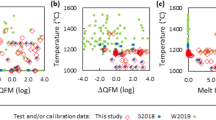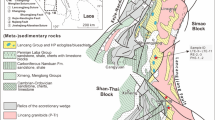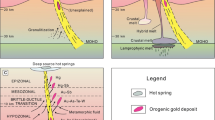Abstract
This work presents the first chemical and isotopic (δ13C-CO2, δ13C-CH4, 3He, 4He, 20Ne, 40Ar, 36Ar, δ18O, and δD) data for fluid discharges from Guallatiri volcano, a remote and massive stratovolcano, which is considered as the second most active volcano of the Central Volcanic Zone (CVZ) in northern Chile. Fumarolic gases had outlet temperatures of between 80.2 and 265 °C, and showed a significant magmatic fluid contribution marked by the occurrence of SO2, HCl, and HF that are partially scrubbed by a hydrothermal aquifer. The helium isotope ratios (< 3.2) were relatively low compared to those of other active volcanoes in CVZ, possibly due to contamination of the magmatic source by 4He-rich crust and/or crustal fluid addition to the hydrothermal reservoir. Geothermometry in the H2O-CO2-CO-H2-CH4 system suggests equilibrium temperatures of up to 320 °C attained in a vapor phase at redox conditions intermediate between those typical of hydrothermal and magmatic environments. Thermal springs located 12 km northwest of the volcano’s summit had outlet temperatures of up to 50.1 °C, neutral to slightly basic pH, and a sodium bicarbonate composition, typical of distal fluid discharges in volcanic systems. Cold springs at the base of the volcanic edifice, showing a calcium sulfate composition, were likely produced by interaction of shallow meteoric water with CO2- and H2S-rich gases. A geochemical conceptual model was constructed to graphically represent these results, which can be used as an indication for future geochemical monitoring and volcanic hazard assessment.











Similar content being viewed by others
References
Aguilera F (2008) Origen y naturaleza de los fluidos en los sistemas volcánicos, geotermales y termales de baja entalpía de la Zona Volcánica Central (ZVC) entre los 17 43’S y 25 10’S. PhD Thesis, Universidad Católica del Norte, Antofagasta
Aguilera F, Tassi F, Darrah T, Moune S, Vaselli O (2012) Geochemical model of a magmatic–hydrothermal system at the Lastarria volcano, northern Chile. Bull Volcanol 74(1):119–134. https://doi.org/10.1007/s00445-011-0489-5
Aguilera F, Layana S, Rodríguez-Díaz A, González C, Cortés J, Inostroza M (2016) Hydrothermal alteration, fumarolic deposits and fluids from Lastarria volcanic complex: a multidisciplinary study. Andean Geol 43(2):166–196. https://doi.org/10.5027/andgeoV43n2-a02
Aravena D, Villalón I, Sánchez P (2015) Igneous related geothermal resource in the Chilean Andes. Extended Abstract, Proceedings World Geothermal Congress 2015, Melbourne
Bernard B, Brooks JM, Sackett WM (1977) A geochemical model for characterization of hydrocarbon gas sources in marine sediments. Extended Abstract, Offshore Technology Conference, Houston https://doi.org/10.4043/2934-MS
Bourdon B, Wörner G, Zindler A (2000) U-series evidence for crustal involvement and magma residence times in the petrogenesis of Parinacota volcano, Chile. Contrib Mineral Petrol 139(4):458–469
Capaccioni B, Aguilera F, Tassi F, Darrah T, Poreda RJ, Vaselli O (2011) Geochemical and isotopic evidences of magmatic inputs in the hydrothermal reservoir feeding the fumarolic discharges of Tacora volcano (northern Chile). J Volcanol Geotherm Res 208(3–4):77–85. https://doi.org/10.1016/j.jvolgeores.2011.09.015
Capasso G, Favara R, Francofonte S, Inguaggiato S (1999) Chemical and isotopic variations in fumarolic discharge and thermal waters at Vulcano Island (Aeolian Islands, Italy) during 1996: evidence of resumed volcanic activity. J Volcanol Geotherm Res 88(3):167–175
Casertano L (1963) General characteristics of active Andean volcanoes and a summary of their activities during recent centuries. B Seismol Soc Am 53(6):1415–1433
Chaffaut I, Coudrain-Ribstein A, Michelot JL, Pouyaud B (1998) Précipitations d’altitude du Nord-Chile, origine des sources de vapeur et données isotopiques. Bull Inst Fr Etudes Andines 27:367–384
Chiodini G, Marini L (1998) Hydrothermal gas equilibria: the H2O-H2-CO2-CO-CH4 system. Geochim Cosmochim Acta 62(15):2673–2687. https://doi.org/10.1016/S0016-7037(98)00181-1
Chiodini G, Caliro S, Cardellini C, Granieri D, Avino R, Baldini A, Donnini M, Minopoli C (2010) Long-term variations of the Campi Flegrei, Italy, volcanic system as revealed by the monitoring of hydrothermal activity. J Geophys Res B: Solid Earth 115(B3)
Craig H (1961) Isotopic variations in meteoric waters. Science 133(3465):1702–1703
D'Amore F, Panichi C (1980) Evaluation of deep temperatures of hydrothermal systems by a new gas geothermometer. Geochim Cosmochim Acta 44(3):549–556
de Moor JM, Aiuppa A, Pacheco J, Avard G, Kern C, Liuzzo M, Martínez M, Giudice G, Fischer T (2016) Short-period volcanic gas precursors to phreatic eruptions: insights from Poás volcano, Costa Rica. Earth Planet Sci Lett 442:218–227
Di Piazza A, Rizzo AL, Barberi F, Carapezza ML, De Astis G et al (2015) Geochemistry of the mantle source and magma feeding system beneath Turrialba volcano, Costa Rica. Lithos 232:319–335. https://doi.org/10.1016/j.lithos.2015.07.012
Dimitrakopoulos R, Muehlenbachs K (1987) Biodegradation of petroleum as a source of 13C-enriched carbon dioxide in the formation of carbonate cement. Chem Geol 65:283–291
Etiope G (2009) Natural emissions of methane from geological seepage in Europe. Atmos Environ 43(7):1430–1443. https://doi.org/10.1016/j.atmosenv.2008.03.014
Fiebig J, Stefánsson A, Ricci A, Tassi F, Viveiros F, Silva S, Lopez TM, Schreiber C, Hofmann S, Mountain BW (2019) Abiogenesis not required to explain the origin of volcanic-hydrothermal hydrocarbons. Geochem Persp Lett 11:23–27. https://doi.org/10.7185/geochemlet.1920
Fischer TP (2008) Fluxes of volatiles (H2O, CO2, N2, Cl, F) from arc volcanoes. Geochem J 42(1):21–38. https://doi.org/10.2343/geochemj.42.21
Fischer T, Marty B (2005) Volatile abundances in the sub-arc mantle: insights from volcanic and hydrothermal gas discharges. J Volcanol Geotherm Res 140(1–3):205–216
Galimov EM (1988) Sources and mechanisms of formation of gaseous hydrocarbons in sedimentary rocks. Chem Geol 71(1–3):77–95
García G, Gardeweg M, Clavero J, Hérail G (2004) Hoja Arica, Región de Tarapacá. Servicio Nacional Geología y Minería, Carta Geológica de Chile, Serie Geología Básica (84): 1–152
Gardeweg M, Amigo A, Matthews S, Sparks R, Clavero J (2011) Geología del volcán Lascar, región de Antofagasta. Servicio Nacional de Geología y Minería, Carta Geológica de Chile, Serie Geología Básica (131): 1–42
Giggenbach WF (1980) Geothermal gas equilibria. Geochim Cosmochim Acta 44(12):2021–2032
Giggenbach WF (1987) Redox processes governing the chemistry of fumarolic gas discharges from White Island, New Zealand. Appl Geochem 2(2):143–161
Giggenbach WF (1990) The chemistry of fumarolic vapor and thermal-spring discharges from the Nevado del Ruiz volcanic-magmatic-hydrothermal system, Colombia. J Volcanol Geotherm Res 42(1–2):13–39
Giggenbach WF (1992) Isotopic shifts in waters from geothermal and volcanic systems along convergent plate boundaries and their origin. Earth Planet Sci Lett 113:495–510
Giggenbach WF (1996) Chemical composition of volcanic gases. In: Scarpa R, Tilling R (eds) Monitoring and mitigation of volcano hazards. Springer, Berlin, pp 221–256
Gliß J, Stebel K, Kylling A, Sudbø A (2017) Optical flow gas velocity analysis in plumes using UV cameras—implications for SO2-emission-rate retrievals investigated at Mt. Etna, Italy, and Guallatiri, Chile. Atmos. Meas. Tech. Discuss 2017: 1–30
Global Volcanism Program (2013) Guallatiri (355020) in volcanoes of the world, v. 4.8.0. Venzke, E (ed.). Smithsonian Institution. Downloaded June 25 2019 (https://volcano.si.edu/volcano.cfm?vn=355020). https://doi.org/10.5479/si.GVP.VOTW4-2013
González-Ferrán O (1995) Volcanes de Chile. Instituto Geográfico Militar, Santiago de Chile
Harris A, Carniel R, Patrick M, Dehn J (2004) The sulfur flow fields of the Fossa di Vulcano. Bull Volcanol 66(8):749–759
Hilton DR, Hammerschmidt K, Teufel S, Friedrichsen H (1993) Helium isotope characteristics of Andean geothermal fluids and lavas. Earth Planet Sci Lett 120(3–4):265–282. https://doi.org/10.1016/0012-821X(93)90244-4
Hilton DR, Fischer TP, Marty B (2002) Noble gases and volatile recycling at subduction zones. Rev Mineral Geochem 47:319–370. https://doi.org/10.2138/rmg.2002.47.9
Hoefs J, Hoefs J (2009) Stable isotope geochemistry. Springer, Berlin
Holloway JR (1984) Graphite–CH4–H2O–CO2 equilibria at low-grade metamorphic conditions. Geology 12:455–458
Hora JM, Singer BS, Wörner G, Clavero J (2007) Eruptive flux during periods of cone growth and collapse at Volcan Parinacota, Chilean CVZ, from a high-resolution 40Ar/39Ar eruptive chronology. Geol Soc Am Bull 119:343–362
Horita J, Berndt ME (1999) Abiogenic methane formation and isotopic fractionation under hydrothermal conditions. Science 285(5430):1055–1057
Inostroza M, Aguilera F, Menzies A, Layana S, González C, Ureta G, Sepúlveda J, Scheller S, Böehm S, Barraza M, Tagle R, Patzschke M (2020) Deposition of metals and metalloids in the fumarolic fields of Guallatiri and Lastarria volcanoes, northern Chile. J Volcanol Geotherm Res 393:106803
International Atomic Energy Agency (2009) Laser spectroscopic analysis of liquid water samples for stable hydrogen and oxygen isotopes. IAEA.
Jacquemin M, Beuls A, Ruiz P (2010) Catalytic production of methane from CO2 and H2 at low temperature: insight on the reaction mechanism. Catal Today 157:462–466. https://doi.org/10.1016/j.cattod.2010.06.016
James AT, Burns BJ (1984) Microbial alteration of subsurface natural gas accumulations. AAPG Bull 68(8):957–960
Mamani M, Wörner G, Sempere T (2010) Geochemical variations in igneous rocks of the Central Andean orocline (13°S to 18°S): tracing crustal thickening and magma generation through time and space. GSA Bull 122:162–182. https://doi.org/10.1130/B26538.1
Mamyrin BA, Tolstikhin IN (1984) Helium isotopes in nature. In: Fyfe WS (ed) Development in geochemistry. Elsevier, Amsterdam, p 274
Marinovic N, Lahsen A (1984) Hoja Calama, región de Antofagasta. Servicio Nacional de Geología y Minería. Carta Geológica de Chile n°58, pp. 144
McCollom TM (2003) Formation of meteorite hydrocarbons from thermal decomposition of siderite (FeCO3). Geochim Cosmochim Acta 67(2):311–317
Melián G, Tassi F, Pérez N, Hernández P, Sortino F, Vaselli O, Padrón E, Nolasco D, Barrancos J, Padilla G, Rodríguez F, Dionis S, Calvo D, Notsu K, Rodríguez F (2012) A magmatic source for fumaroles and diffuse degassing from the summit crater of Teide volcano (Tenerife, Canary Islands): a geochemical evidence for the 2004–2005 seismic–volcanic crisis. Bull Volcanol 74(6):1465–1483
Montegrossi G, Tassi F, Vaselli O, Buccianti A, Garofalo K (2001) Sulfur species in volcanic gases. Anal Chem 73:3709–3715
Naranjo J (1985) Sulphur flows at Lastarria volcano in the North Chilean Andes. Nature 313(6005):778–780
Naranjo J (1988) Coladas de azufre de los volcanes Lastarria y Bayo en el norte de Chile: Reología, génesis e importancia en geología planetaria. Rev Geol Chile 15(1): 3–12
Neubeck A, Duc NT, Bastviken D, Crill P, Holm NG (2011) Formation of H2 and CH4 by weathering of olivine at temperatures between 30 and 70°C. Geochem T 12(1):6. https://doi.org/10.1186/1467-4866-12-6
Oremland RS, Miller LG, Whiticar MJ (1987) Sources and flux of natural gases from Mono Lake, California. Geochim Cosmochim Acta 51(11):2915–2929
Ozima M, Podosek F, (1983) Noble gas geochemistry. Cambridge University Press, Cambridge
Ozima M, Podosek FA (2002) Noble gas geochemistry. Cambridge University Press, Cambridge
Pallasser RJ (2000) Recognising biodegradation in gas/oil accumulations through the δ13C compositions of gas components. Org Geochem 31(12):1363–1373. https://doi.org/10.1016/S0146-6380(00)00101-7
Poreda R, Craig H (1989) Helium isotope ratios in circum-Pacific volcanic arcs. Nature 338:473–478. https://doi.org/10.1038/338473a0
Prinzhofer A, Battani A (2003) Gas isotopes tracing: an important tool for hydrocarbons exploration. Oil Gas Sci Technol 58(2):299–311
Rizzo AL, Barberi F, Carapezza ML, Di Piazza A, Francalanci L et al (2015) New mafic magma refilling a quiescent volcano: evidence from He-Ne-Ar isotopes during the 2011–2012 unrest at Santorini, Greece. Geochem Geophys Geosyst 16(3):798–814. https://doi.org/10.1002/2014GC005653
Rouwet D, Sandri L, Marzocchi W, Gottsmann J, Selva J, Tonini R, Papale P (2014) Recognizing and tracking volcanic hazards related to non-magmatic unrest: a review. J Appl Volcanol 3(1):1–17
Sano Y, Marty B (1995) Origin of carbon in fumarolic gas from island arcs. Chem Geol 119:265–274. https://doi.org/10.1016/0009-2541(94)00097-R
Schoell M (1980) The hydrogen and carbon isotopic composition of methane from natural gases of various origins. Geochim Cosmochim Acta 44(5):649–661. https://doi.org/10.1016/0016-7037(80)90155-6
Schoell M (1988) Multiple origins of methane in the Earth. Chem Geol 71:1–10. https://doi.org/10.1016/0009-2541(88)90101-5
Sepúlveda JP (2018) Evolución geológica del Complejo Volcánico Guallatiri, región de Arica y Parinacota, Norte de Chile. Undergraduate Thesis, Universidad Católica del Norte, Antofagasta, Chile
SERNAGEOMIN (2015a) Ranking de peligrosidad de los volcanes activos de Chile. Servicio Nacional de Geología y Minería, Santiago
SERNAGEOMIN (2015b) Reporte Especial de Actividad Volcánica (REAV), región de Arica y Parinacota (Año 2015, Mayo 31, 14:00 local time), Santiago
SERNAGEOMIN (2019) Reporte de Actividad Volcánica (RAV) N° 11, noviembre 2019, región de Arica y Parinacota. Santiago
Stolper D, Lawson M, Davis C, Ferreira A, Neto E, Ellis G, Lewan M, Martini A, Tang I, Schoell M, Sessions A, Eiler J (2014) Formation temperatures of thermogenic and biogenic methane. Science 344(6191):1500–1503
Symonds RB, Gerlach TM, Reed MH (2001) Magmatic gas scrubbing: implications for volcano monitoring. J Volcanol Geotherm Res 108:303–341. https://doi.org/10.1016/S0377-0273(00)00292-4
Taran YA, Pokrovsky BG, Esikov AD (1989) Deuterium and oxygen-18 in fumarolic steam and amphiboles from some Kamchatka volcanoes: “andesitic waters”. Dokl Akad Nauk SSSR 304:440–443
Tassi F, Martinez C, Vaselli O, Capaccioni B, Viramonte J (2005) Light hydrocarbons as redox and temperature indicators in the geothermal field of El Tatio (northern Chile). Appl Geochem 20(11):2049–2062. https://doi.org/10.1016/j.apgeochem.2005.07.013
Tassi F, Aguilera F, Vaselli O, Medina E, Tedesco D, Delgado Huertas A, Poreda R, Kojima S (2009) The magmatic- and hydrothermal dominated fumarolic system at the Active Crater of Lascar volcano, northern Chile. Bull Volcanol 71:171–183. https://doi.org/10.1007/s00445-008-0216-z
Tassi F, Aguilera F, Darrah T, Vaselli O, Capaccioni B, Poreda RJ, Delgado Huertas A (2010) Fluid geochemistry of hydrothermal systems in the Arica-Parinacota, Tarapacá and Antofagasta regions (northern Chile). J Volcanol Geotherm Res 192(1–2):1–15. https://doi.org/10.1016/j.jvolgeores.2010.02.006
Tassi F, Aguilera F, Vaselli O, Darrah T, Medina E (2011) Gas discharges from four remote volcanoes in northern Chile (Putana, Olca, Irruputuncu and Alitar): a geochemical survey. Ann Geophys-Italy 54(2)
Tassi F, Fiebig J, Vaselli O, Nocentini M (2012) Origins of methane discharging from volcanic-hydrothermal, geothermal and cold emissions in Italy. Chem Geol 310:36–48. https://doi.org/10.1016/j.chemgeo.2012.03.018
Tedesco D (1997) Systematic variations in the 3He/4He ratio and carbon of fumarolic fluids from active volcanic areas in Italy: evidence for radiogenic 4He and crustal carbon addition by the subducting African plate? Earth Planet Sci Lett 151(3–4):255–269
Tedesco D, Miele G, Sano Y, Toutain JP (1995) Helium isotopic ratio in Vulcano island fumaroles: temporal variations in shallow level mixing and deep magmatic supply. J Volcanol Geotherm Res 64(1–2):117–128. https://doi.org/10.1016/0377-0273(94)00045-I
Venturi S, Tassi F, Bicocchi G, Cabassi J, Capecchiacci F, Capasso G, Vaselli O, Ricci A, Grassa F (2017) Fractionation processes affecting the stable carbon isotope signature of thermal waters from hydrothermal/volcanic systems: the examples of Campi Flegrei and Vulcano Island (southern Italy). J Volcanol Geotherm Res 345:46–57
Villemant B, Hammouya G, Michel A, Semet M, Komorowski J, Boudon G, Cheminée, J. L (2005) The memory of volcanic waters: shallow magma degassing revealed by halogen monitoring in thermal springs of La Soufrière volcano (Guadeloupe, Lesser Antilles). Earth Planet Sci Lett 237(3–4): 710–728
von Huene R, Ranero CR (2003) Subduction erosion and basal friction along the sediment-starved convergent margin off Antofagasta, Chile. J Geophys Res Solid Earth 108(B2). https://doi.org/10.1029/2001JB001569
Watts RB, Clavero J, Sparks RS (2014) Origen y emplazamiento del Domo Tinto, volcán Guallatiri, Norte de Chile. Andean Geol 41(3)
Welhan JA (1988) Origins of methane in hydrothermal systems. Chem Geol 71(1–3):183–198. https://doi.org/10.1016/0009-2541(88)90114-3
Whiticar MJ (1999) Carbon and hydrogen isotope systematics of bacterial formation and oxidation of methane. Chem Geol 161(1–3):291–314. https://doi.org/10.1016/S0009-2541(99)00092-3
Whiticar MJ, Suess E (1990) Hydrothermal hydrocarbon gases in the sediments of the King George Basin, Bransfield Strait, Antarctica. Appl Geochem 5(1–2):135–147. https://doi.org/10.1016/0883-2927(90)90044-6
Whiticar MJ, Faber E, Schoell M (1986) Biogenic methane formation in marine and freshwater environments: CO2 reduction vs. acetate fermentation—isotope evidence. Geochim Cosmochim Acta 50(5):693–709. https://doi.org/10.1016/0016-7037(86)90346-7
Acknowledgments
This study was funded by the Comisión Nacional de Investigación Científica y Tecnológica (CONICYT)-PCHA/Doctorado Nacional/2016-21160172 and the project Intercambio de Investigadores Chile-Italia, convocatoria 2017, Programa de Cooperación Internacional ITAL17002 funded by CONICYT Chile and the Italian Ministry of Foreign Affairs and International Cooperation. We thank Severina Mamani and Clemente Ticlia for the accommodation in the Chirigualla hamlet, Gabriela Daza and María Paz Reyes for its valuable help in the field trips and Andrea Rizzo and Mariano Tantillo of INGV-Sezione di Palermo, for performing analyses of noble gas isotopes. We also thank Dr. Taryn Lopez and Dr. Brendan McCormick for their valuable comments and suggestions that substantially improved the original version of the manuscript.
Author information
Authors and Affiliations
Contributions
All authors contributed to the study conception and design. Material preparation, sampling, and data collection were performed by Manuel Inostroza, José Sepúlveda, and Felipe Aguilera. Laboratory analyses were performed by Franco Tassi, Francesco Capecchiacci, Stefania Venturi, and Giorgio Capasso. The first draft of the manuscript was written by Manuel Inostroza and all authors commented on previous versions of the manuscript. All authors read and approved the final manuscript.
Corresponding author
Additional information
Editorial responsibility: T.P. Fischer
Rights and permissions
About this article
Cite this article
Inostroza, M., Tassi, F., Aguilera, F. et al. Geochemistry of gas and water discharge from the magmatic-hydrothermal system of Guallatiri volcano, northern Chile. Bull Volcanol 82, 57 (2020). https://doi.org/10.1007/s00445-020-01396-2
Received:
Accepted:
Published:
DOI: https://doi.org/10.1007/s00445-020-01396-2




